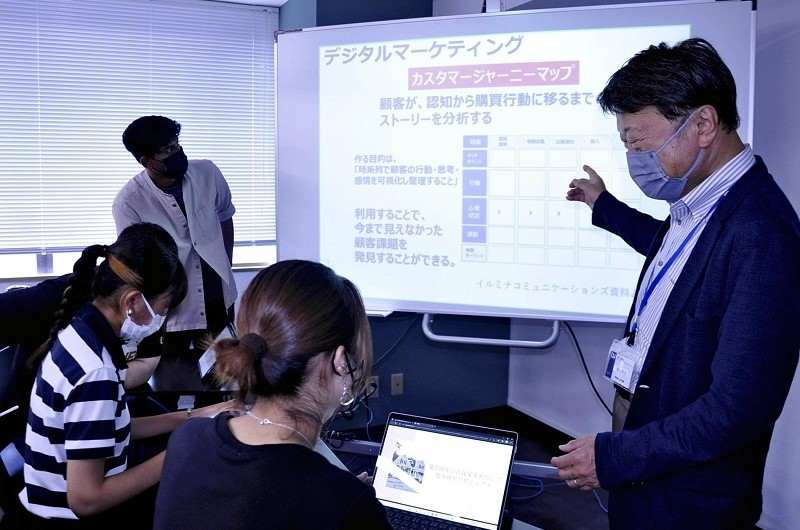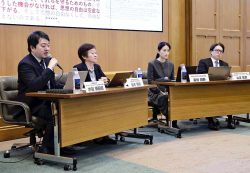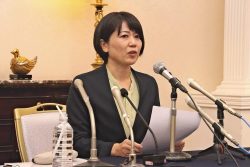
Students study digital marketing at Tokyo Business and Language College, a vocational school in Tokyo, in June.
1:00 JST, July 28, 2022
Companies are increasingly integrating digital transformation (DX) into their business models. But to fully leverage associated technologies and make business operations more efficient and innovative, it is imperative for Japan to expeditiously create and nurture a “digital workforce” well-versed in data analysis and artificial intelligence.
As part of this push, the central government is striving to improve and support technical colleges and vocational schools.
Work-ready manpower
The tentatively titled Kamiyama Marugoto Technical College will open next spring in the town of Kamiyama, Tokushima Prefecture. The college, supported by IT entrepreneurs and others, will be the first five-year technical college to be established in Japan during the past 20 years. Each academic year will comprise 40 students who will be schooled for free, funded — it is hoped — by donations and funds from IT firms and private individuals.
During the nation’s rapid economic growth period in the 1960s, many technical colleges sprang up with the aim of producing technicians and engineers. In Japan, technical colleges are deemed to be higher education institutions equivalent to colleges and universities.
The nation currently has 51 state-run technical colleges, three municipally run colleges and three privately administered colleges, with a combined total of about 53,000 students. Students enter these schools after graduating from junior high school and receive a five-year education, with emphasis on research and practical training centered around engineering-based coursework.
More than 30% of teaching staff have work experience at private companies and other establishments, and more than 90% of teachers hold a doctorate or master’s degree.
In the IT industry, graduates from technical colleges are highly sought-after as “work-ready” personnel.
Technical college curriculums are not bound by the education ministry’s Course of Study, which means technical experts without a teaching license can teach classes. Against this background, the new college in Kamiyama can provide even first-year students with practical courses such as programming and include prominent entrepreneurs among its lecturers.
“During their seven years at high schools and universities, students are encouraged to study for entrance exams and conduct job-hunting activities,” said Takaki Matsuzaka, who is slated to become secretary-general of the new college. “But at technical colleges we can develop human resources who can be internationally competitive [immediately].”
Trailing South Korea, China
Based on its existing educational framework, Japan is not currently capable of responding to the serious ongoing shortage in digital manpower.
In 2017, Shiga University established its Faculty of Data Science to foster digital manpower; many other universities quickly followed suit. The digitization of society and the adoption of DX within companies has accelerated amid the novel coronavirus pandemic, but there is dearth of suitably skilled staff to match this rapidly developing pace.
According to the Economy, Trade and Industry Ministry, about 1.13 million people are expected to be working in the IT industry by 2030, representing a projected personnel shortfall of about 790,000.
In the International Institute for Management Development’s World Digital Competitiveness Ranking for 2021, Japan ranked 28th among the 64 countries and territories examined, behind South Korea (12th) and China (15th).
“Manpower investment” is a key pillar of the Basic Policy on Economic and Fiscal Management and Reform, adopted by the Cabinet in June. The government hopes that technical colleges and vocational schools will act as a foundational core to develop a digital workforce, in tandem with universities.
The basic policy also says the government will accelerate its response to changes in society, by, for instance, developing an innovation-focused workforce ready to deal with digitization.
The Education, Culture, Sports, Science and Technology Ministry has earmarked ¥62.5 billion to upgrade 51 state-run technical colleges this fiscal year. The funds will help promote the development of human resources capable of catalyzing technological innovation. However, as there are only 57 technical colleges — including publicly and privately run technical colleges — it is essential to utilize the nation’s about 2,700 vocational and professional schools, which increasingly are putting priority on digital education.
Next spring, Japan Electronics College in Tokyo will newly establish its DX Specialist Department to develop personnel to promote DX in the workplace. For its part, The Yomiuri College of Tokyo established a program called Cross Media Information System in 2016, which trains engineers.
The education ministry also collaborates with industries that employ graduates, and gives subsidies to vocational and professional schools that develop programs aimed at teaching digital skills. “We’d like to develop a work-ready labor force that can deal effectively with industry challenges,” a ministry official said.
Diverse options
At present, about 98% of students enter senior high school. Most enroll in schools that offer general courses and more than 60% later go on to colleges and universities.
Yet, many companies and local governments are keen to source work-ready personnel. “It’s too late to develop a digital workforce after people have enrolled at universities,” an economy industry observer said.
University of Tokyo Prof. Yutaka Matsuo, an expert in AI research, said: “The education system in which most students undertake four-year courses at colleges and universities has served to produce high-quality workers on a massive scale. However, for advances to be made toward a digital society, human resources capable of technological innovation, as well as others to help underpin related workplaces, are required to ensure diverse options in terms of learning and future career paths.”
It is also crucial to improve conditions to help boost teachers’ specialist knowledge. “There needs to be awareness within the education system regarding the development of human resources who can meet the needs of our society as times change,” Matsuo said.
"Science & Nature" POPULAR ARTICLE
-

Mass Oyster Die-Offs Confirmed in Japan’s Seto Inland Sea; High Water Temperature Cited as Primary Cause
-

Genome Study Reveals Milestone in History of Cat Domestication
-

Big Leap in Quest to Get to Bottom of Climate Ice Mystery
-

Security Camera Footage Vulnerable to Outside Access; Investigation Finds 3,000 Pieces Exposed Online
-

Star-eating Black Hole Unleashes Record-setting Energetic Flare
JN ACCESS RANKING
-

Japan’s Hopes for Seafood Exports Shot Down in China Spat
-

Keidanren Chairman Yoshinobu Tsutsui Visits Kashiwazaki-Kariwa Nuclear Power Plant; Inspects New Emergency Safety System
-

Japan to Charge Foreigners More for Residence Permits, Looking to Align with Western Countries
-

Imports of Rare Earths from China Facing Delays, May Be Caused by Deterioration of Japan-China Relations
-

Japan Exports Rise in October as Slump in U.S. Sales Eases























